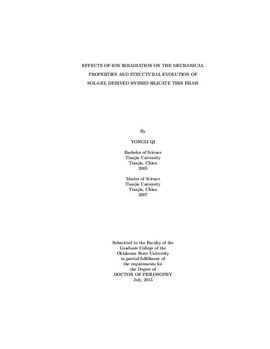| dc.contributor.advisor | Lucca, Don A. | |
| dc.contributor.author | Qi, Yongli | |
| dc.date.accessioned | 2016-09-29T18:42:25Z | |
| dc.date.available | 2016-09-29T18:42:25Z | |
| dc.date.issued | 2015-07 | |
| dc.identifier.uri | https://hdl.handle.net/11244/45302 | |
| dc.description.abstract | A study of the effects of ion irradiation on the surface mechanical properties and structural evolution of sol-gel derived hybrid silicate thin films has been conducted. Green films were synthesized through a sol-gel process using tetraethoxysilane (TEOS) and methyltriethoxysilane (MTES) as precursors and acetic acid as a catalyst, and spin-coated onto (100) Si wafers. Through heat treatment or ion irradiation, the green films were converted to their ceramic state. Heat treatment was performed in ambient air or in vacuum at temperatures of 300 - 800°C. Ion irradiation was performed using 200 keV H+, 400 keV N2+, 1 MeV Cu+ 4 MeV Cu2+ or 9 MeV Cu3+ with fluences of 1 MeV Cu+, 4 MeV Cu2+ and 9 MeV Cu3+ with fluences of 1 x 10^13 to 2 x 10^ 17 ions/cm2. The resultant films were investigated by atomic force microscopy (AFM), nanoindentation, Rutherford backscattering spectrometry (RBS), elastic recoil detection (ERD) and scanning electron microscopy (SEM). | |
| dc.description.abstract | In order to better understand the chemical structure of the green films, the theoretical chemical composition was obtained based on the starting materials and the chemical reactions during hydrolysis and condensation. The difference in the mechanical properties of the films heat treated in ambient air and in vacuum was attributed to the thermal stability and decomposition path of the organic components in the different environments, thus affecting the resulting microstructure. | |
| dc.description.abstract | Investigation of the film shrinkage and mechanical properties of the ion irradiated films led to a conclusion that the mechanical properties of the films had a noticeable increase when the films were irradiated at a fluence of 1 x 10^14 ions/cm2 or above. During irradiation, the majority of H was released and some O and C were also released, as evidenced by the decreasing H/Si, C/Si and O/Si ratios with increasing fluence. The Voigt and Reuss model was employed to evaluate the elastic modulus of the fully converted films by considering them as a composite. It was observed the reduced elastic modulus of the fully converted films after ion irradiation increased with increasing Si-C bond concentration, consistent with that of the silicon oxycarbide synthesized by heat treatment in Ar flow or by RF sputtering. | |
| dc.description.abstract | A plausible explanation of the structural evolution during ion irradiation was developed by analyzing the H/Si, O/Si, and C/Si ratios with increasing fluence, the difference in the stopping power, and the theoretical chemical composition of the green films. The possible schemes of forming CSi4 were also discussed. | |
| dc.format | application/pdf | |
| dc.language | en_US | |
| dc.rights | Copyright is held by the author who has granted the Oklahoma State University Library the non-exclusive right to share this material in its institutional repository. Contact Digital Library Services at lib-dls@okstate.edu or 405-744-9161 for the permission policy on the use, reproduction or distribution of this material. | |
| dc.title | Effects of ion irradiation on the mechanical properties and structural evolution of sol-gel derived hybrid silicate thin films | |
| dc.contributor.committeeMember | Grischkowsky, Daniel R. | |
| dc.contributor.committeeMember | Pagilla, Prabhakar R. | |
| dc.contributor.committeeMember | Klopfstein, Matthew Joseph | |
| osu.filename | Qi_okstate_0664D_14274.pdf | |
| osu.accesstype | Open Access | |
| dc.type.genre | Dissertation | |
| dc.type.material | Text | |
| thesis.degree.discipline | Mechanical and Aerospace Engineering | |
| thesis.degree.grantor | Oklahoma State University | |
